Resources
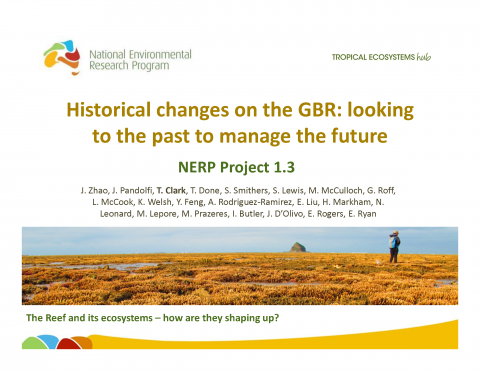 Zhao J, Pandolfi J, Clark T, Done T, Smithers S, Lewis S, McCulloch M, Roff G, McCook L, Welsh K, Feng Y, Rodriguez-Ramirez A, Liu E, Markham H, Leonard N, Lepore M, Prazeres M, Butler I, D'Olivo J, Rogers E, Ryan E; Historical changes on the GBR: looking to the past to manage the future; Thursday 9th May 2013.
Zhao J, Pandolfi J, Clark T, Done T, Smithers S, Lewis S, McCulloch M, Roff G, McCook L, Welsh K, Feng Y, Rodriguez-Ramirez A, Liu E, Markham H, Leonard N, Lepore M, Prazeres M, Butler I, D'Olivo J, Rogers E, Ryan E; Historical changes on the GBR: looking to the past to manage the future; Thursday 9th May 2013.
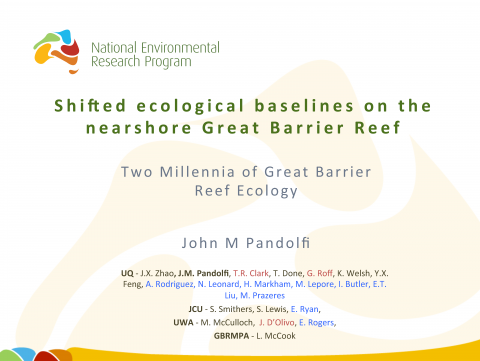 John Pandolfi (UQ); Shifted ecological baselines on the nearshore Great Barrier Reef; Wednesday 5th November 2014.
John Pandolfi (UQ); Shifted ecological baselines on the nearshore Great Barrier Reef; Wednesday 5th November 2014.
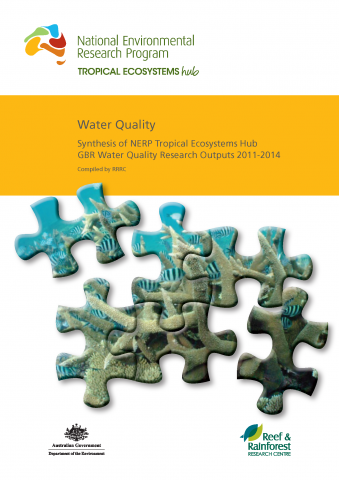 Devlin, M., Fabricius, K., Negri, A., Brodie, J., Waterhouse, J., Uthicke, S., Collier, C., Pressey, B., Augé, A., Reid, B., Woodberry, O., Zhao, J-x., Clarke, T., Pandolfi, J., Bennett, J. (2015) Water Quality - Synthesis of NERP Tropical Ecosystems Hub Water Quality Research Outputs 2011-2014.
Devlin, M., Fabricius, K., Negri, A., Brodie, J., Waterhouse, J., Uthicke, S., Collier, C., Pressey, B., Augé, A., Reid, B., Woodberry, O., Zhao, J-x., Clarke, T., Pandolfi, J., Bennett, J. (2015) Water Quality - Synthesis of NERP Tropical Ecosystems Hub Water Quality Research Outputs 2011-2014.
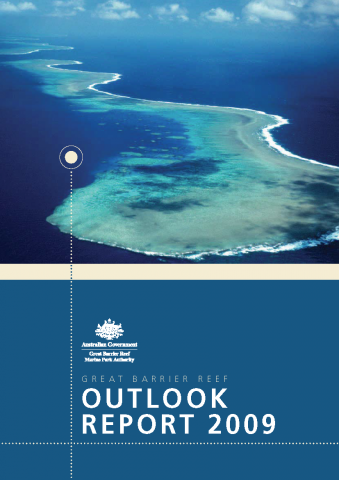 The Great Barrier Reef Outlook Report 2009 is a stock-take of the Great Barrier Reef, its management and its future.
The Great Barrier Reef Outlook Report 2009 is a stock-take of the Great Barrier Reef, its management and its future.
The aim of the Outlook Report is to provide information about:
- The condition of the ecosystem of the Great Barrier Reef Region (including the ecosystem outside the Region where it affects the Region);
• Social and economic factors influencing the Great Barrier Reef ecosystem;
• Management effectiveness of the Great Barrier Reef; and
• Risk-based assessment of the long-term outlook for the Region.
The Report underpins decision-making for the long term protection of the Great Barrier Reef. It was prepared by the GBRMPA based on the best available information and was independently peer reviewed. Many people contributed to the development of the Outlook Report including:
• Australian and Queensland Government agencies
• Leading Great Barrier Reef scientists and researchers
• Industry representatives
• Advisory committees
• Members of regional communities and the public.
The publication of an Outlook Report was a key recommendation of the review of the Great Barrier Reef Marine Park Act 1975. A report is to be prepared every five years and given to the Minister for Sustainability, Environment, Water, Population and Communities for tabling in both houses of the Australian Parliament.
The Great Barrier Reef Outlook Report 2009 is the first of these reports.
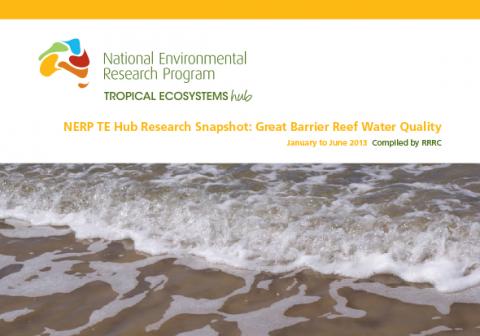 A snapshot of the research progress within the Great Barrier Reef Water Quality node for January to June 2013.
A snapshot of the research progress within the Great Barrier Reef Water Quality node for January to June 2013.
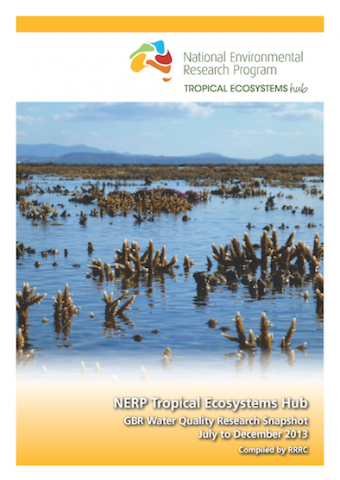 A snapshot of the research progress within the Great Barrier Reef Water Quality node for July to December 2013.
A snapshot of the research progress within the Great Barrier Reef Water Quality node for July to December 2013.

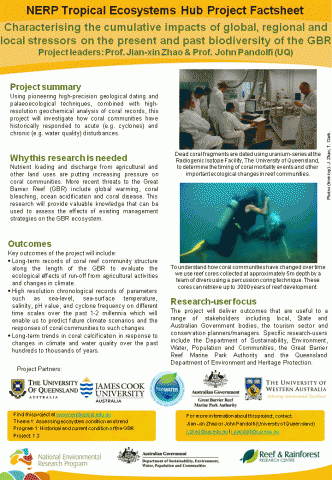 Using pioneering high-precision geological dating and palaeoecological techniques, combined with high-resolution geochemical analysis of coral records, this project will investigate how coral communities have historically responded to acute (e.g. cyclones) and chronic (e.g. water quality) disturbances.
Using pioneering high-precision geological dating and palaeoecological techniques, combined with high-resolution geochemical analysis of coral records, this project will investigate how coral communities have historically responded to acute (e.g. cyclones) and chronic (e.g. water quality) disturbances.

Rodriguez-Ramirez, A., Grove, C.A., Zinke, J, Pandolfi, J.M. , Zhao, J-x. (2014) Coral Luminescence Identifies the Pacific Decadal Oscillation as a Primary Driver of River Runoff Variability Impacting the Southern Great Barrier Reef. PLoS ONE. 9(1): e84305 [doi:10.1371/journal.pone.0084305].

Geochimica et Cosmochimica Acta
Clark, T.R., Zhao, J-x., Roff, G., Feng, Y-x., Done, T.J., Nothdurft, L.D. (2014) Discerning the timing and cause of historical mortality events in modern Porites from the Great Barrier Reef. Geochimica et Cosmochimica Acta. 138, 57-80 [doi:10.1016/j.gca.2014.04.022].

Palaeogeography, Palaeoclimatology and Palaeoecology
Yu, K., Zhao, J-x., Roff, G., Lybolt, M., Feng, Y., Clark, T., Li, S. (2012) High-precision U-series ages of transported coral blocks on Heron Reef (southern Great Barrier Reef) and storm activity during the past century. Palaeogeogrpahy, Palaeoclimatology and Palaeoecology. 337-338, 26-36 [doi: 10.1016/j.palaeo.2012.03.023].
* Partially funded by DEWHA (MTSRF)


